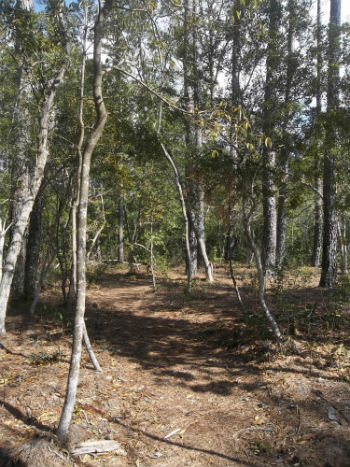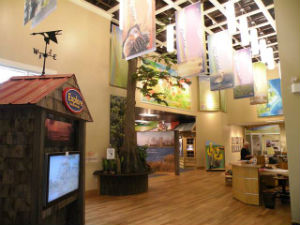 The refuge visitors’ center occupies a striking building on Roanoke Island. Photo: USFWS |
MANTEO– Don’t let the ponderous name deter you. The U.S. Fish and Wildlife Service’s fairly new visitors’ center in a striking gray building on the north end of Roanoke Island offers a quality, hands-on, museum-style learning experience about the 11 wildlife refuges that the service manages along the N.C. coast.
The sign on the side of the building reads ”Coastal North Carolina National Wildlife Refuges Gateway Visitor Center.” Even the less official name, the National Wildlife Refuges Visitor Center, is a mouthful.
Supporter Spotlight
Thankfully, the experience inside is a lot more captivating for adults and tiny visitors alike. It’s a winter dream come true for cold-weather tourists and locals: You’re out of the elements except on the short trail. In summer, the center will provide a respite from the heat and vicious mosquitoes.
The center, which opened last summer, is staffed by knowledgeable volunteers and was built with many eco-friendly features, including the obvious water bottle fill-up built into the water fountain.
The price of a visit is also right: Free, but donations are gladly accepted.
“Are you here for the preschool program?” the volunteer on duty asked me as we entered the building. It was our fourth visit, and my two-year-old gets excited anew each time we arrive. This time, a baby bear, about 4 feet tall, mounted standing up in a clear rectangular box, immediately captivated her.
“No, I didn’t even know about it,” I admitted.
Supporter Spotlight
 The center’s nature trail provides a refreshing way to start the day. Photo: Corinne Saunders |
The group had just left through the back door and was on the trail, the volunteer said, and we could probably catch them. So we hurried through the door, down the ramp and into the woods. A few steps later, we met the group. A somewhat surprised but gracious park ranger handed my daughter a magnifying glass and explained they were looking at different leaves.
The kids, ages 1 to 4, studied leaves, bark and recently sprouted baby pines through their lenses, with the youngest occasionally tasting theirs for good measure.
For a blustery March day, bundling up and meandering the half-mile, pine needle-blanketed path seemed a refreshing way to start the morning. Tall ancient pines blocked much of the wind I’d felt over the bridge and allowed patches of sunshine to fall to the trail floor.
Cindy Heffley, visitor services specialist, led the expedition, and two other park rangers brought up the rear. With such a ratio—six kids, three parents and three park rangers—even safety sticklers would be forced to relax.
Heffley pointed out bumps on some leaves, where she said insects laid their eggs and the leaves grew a protective covering “like a scab” over them. “But it doesn’t hurt the plant,” she added
Informational signs interspersed on the trail presented some facts historical in nature—about Roanoke Island’s first blacks, for example—and others more scientific, with pictures of local plants like bitter gallberry and wax myrtle and animals such as warbler varieties.
Back inside before the group dispersed, the kids examined various leaves that had been strewn on a classroom floor and took home the ones they wanted to keep.
The preschool program takes place Fridays through May 31, from 9:30 a.m. to 10:30 a.m. or from 1 p.m. to 2 p.m. “for the early nappers,” Heffley said.
After the program, my daughter and I wandered through the center’s exhibits. “Can You Find Me?” features a falsified natural habitat containing mounted turtles, birds, deer, bears, a wild turkey, snakes, a squirrel and a raccoon, to name a few. We saw 3-D molds of bear scat and deer droppings, and felt the furs of a bear, deer and the surprisingly soft river otter.
We pushed buttons to light up migration ranges for several bird species on a map. We moved our heads to view from different angles an optical-illusion map, which showed northeastern North Carolina’s current sea level and what one-, two- and three-foot sea rises would look like.
 Hands-on, interactive exhibits are an easy way to learn about the wildlife refuges. Photo: USFWS |
We peeked at the semi-enclosed movie theater area, its walls lined with black-and-white photos, with wooden benches set facing a screen. Pushing a button begins one of three short documentaries, including one on Buffalo City, once the largest community in Dare County but now a ghost town in the Alligator River National Wildlife Refuge.
A prescribed burns display, including a “phone” on which you can listen to audio about controlled refuge burns, was next. Such interactive devices and plentiful buttons in the facility never fail to spark the imagination of the younger crowd.
A walk-through exhibit on flooding and draining refuges featured mounted ducks, one frozen in mid-underwater dive, loving the plentiful water on the “fall” flooded side. The opposite display had mounted rabbits, turtles and wading birds enjoying the low water level of spring.
Nearby, we saw a replica of a water control structure that would be used to flood or drain wildlife refuges and took a turn spinning its red metal wheel.
Intermittent howling from the far corner punctuated the factual narrators’ voices on various displays and led us to the mounted red wolves exhibit. My daughter’s favorite part was the button that lit up an underground den, revealing two wolf pups at play.
The pups were adorable, even though the adults exuded more menacing looks. Still, their authoritative body positions commanded respect.







